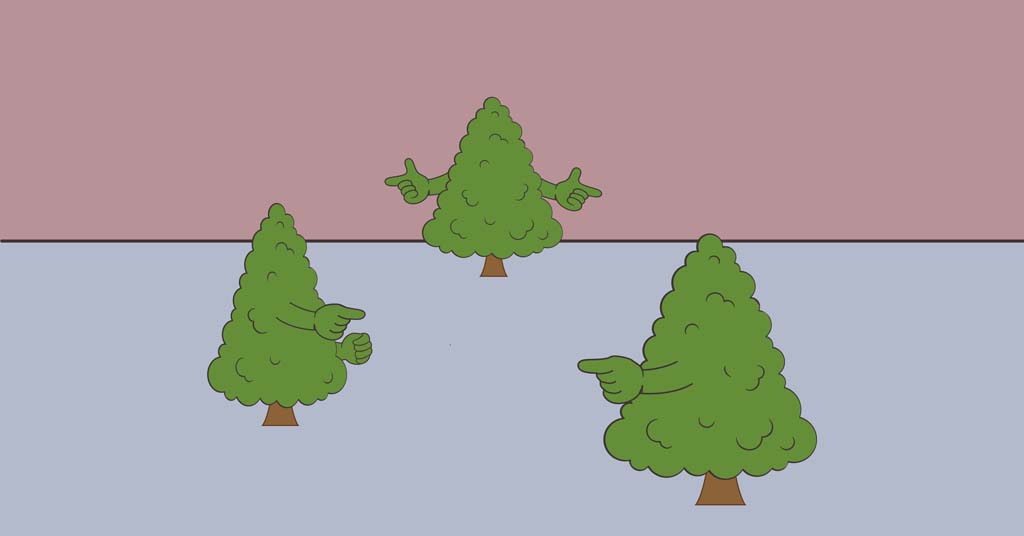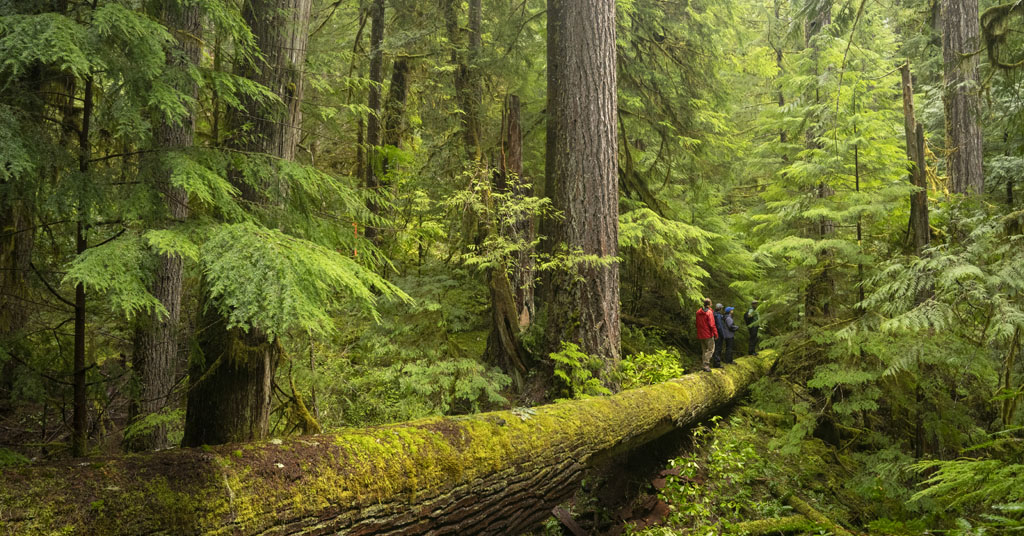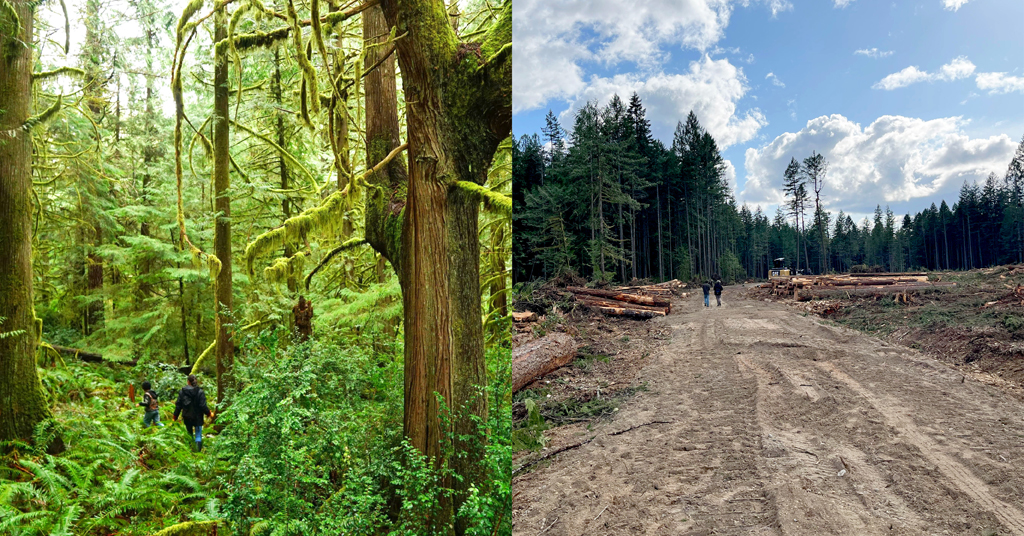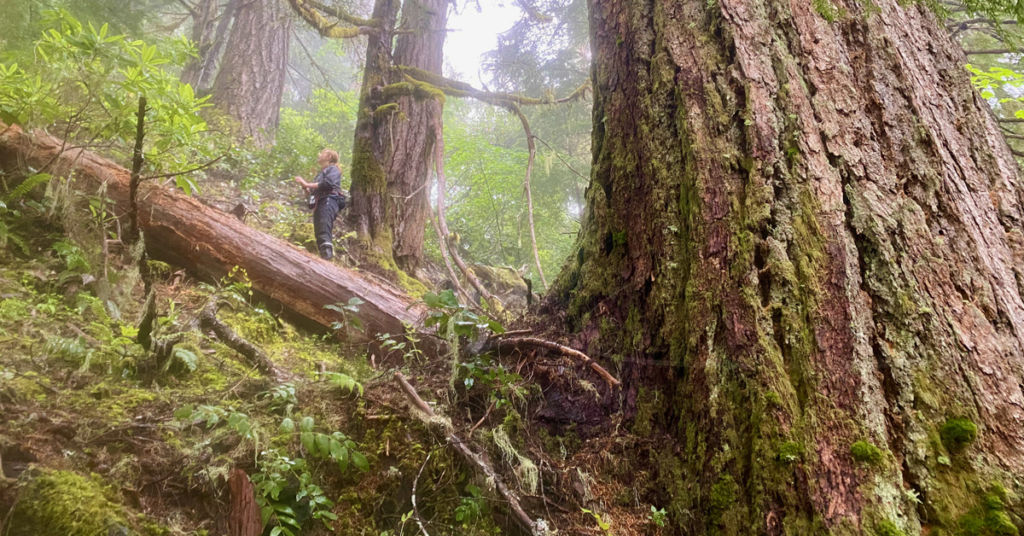More than ever, as the Forest Service seeks to undo logging restrictions, we need to embrace the crucial way old-growth forests keep the planet healthy

Carbon king: Thick, furrowed bark makes this 500-year-old Douglas fir more fire-resistant than younger trees. It also stores more carbon than smaller relatives. Photo by Jurgen Hess
By Marina Richie. October 22, 2020. Everyone loves old-growth forests. Hiking in them. Instagramming them. Sharing them with younger generations.
As Wild Heritage chief scientist Dr. Dominick DellaSala puts it: “Large trees are irreplaceable bio-cultural legacies.”
But big trees and ancient forests offer far more than emotional calm and aesthetic beauty. As the planet faces innumerable connected climate crises—from melting ice caps to species extinction—scientists are continuing to discover myriad ways old-growth trees benefit the global ecology.
Yet people also love logging them.
In August, the U.S. Forest Service announced a proposal to eliminate logging protections for big trees across more than 9 million acres in six national forests in eastern Oregon. Led by DellaSala, more than 100 scientists from around the Columbia River Basin and the world responded by signing a letter condemning the proposal.
MORE: Forest Service wants to limit protections on large trees
“The Forest Service is pulling the rug out from under large tree protections at a time when the recovery of the ecosystem is far from complete and logging large trees will raise fire and climate risks when scientists are calling for more large-tree protections,” stated the letter.
What is ‘old growth’ exactly?
To appreciate the influence old and large trees have on the environment, it’s necessary to understand what “old growth” actually means.
For starters, “old growth” isn’t a scientific term. Nor is there a consensus definition.
The term “old growth” originated with the logging industry in the temperate forests of the Pacific Coast as a way of prioritizing large trees with the highest dollar value. And as a way to rid the forest of what were assumed to be deteriorating trees taking up space where new crops of trees could be planted. It was a term created simply to ascribe economic value.
Although the USFS typically defines an old-growth tree as at least 150 years old, to most scientists and foresters “old growth” is a misnomer.
“A tree is old not because of reaching a certain age, but because of its physical characteristics,” says Jim Lutz, associate professor of wildland resources at Utah State University.

Variety show: This old-growth forest demonstrates species diversity with different-sized Douglas fir, hemlock and grand fir with a vine maple, salal, Oregon grape and California hazel shrub layer. Downed logs, branches and needles provide a deep duff layer on top of soil. Photo by Jurgen Hess
Rather than calling the trees “old growth,” a 2020 British Columbia Provincial government task force offered a mosaic definition: “Old forests meld light and dark; their structural complexity can include large old living trees, large standing dead snags, long downed logs, a multi-layered canopy, horizontal patchiness with canopy gaps that allow understory growth, and hummocky micro-topography.”
While “old growth” remains a common term, most forest scientists prefer terms such as “intact,” “old” or “ancient” forests, reflecting processes that shape these unique ecosystems over centuries.
Carbon storage containers
At least in terms of the modern climate crisis, perhaps the greatest benefit of old-growth forests is their ability to retain carbon. From industrial agriculture to jet travel, human activity is releasing carbon dioxide into the atmosphere with dire climatic consequences.
Big and old trees are carbon-storing champions. The bigger the tree, the more leaves (or needles) it has to harness the sun’s energy, and the more surface area for stockpiling carbon.
Even in death, large standing snags and downed logs retain carbon, cycle nutrients and nurture saplings. Intact forests stow more than half their carbon as organic soil, or within standing and fallen trees that will become part of the rich humus.

Big reveal: In Oregon’s H.J. Andrews Experimental Forest researchers are learning more about how old growth helps global ecology. Photo by Matt Betts
“The large trees are important and even cutting a few of them down has a real effect on carbon,” says Lutz, the lead author of a 2018 study, “Global Importance of Large Trees.” One of Lutz’s study plots was within the Wind River Experimental Forest in the Gifford Pinchot National Forest in Washington.
Its key finding? The largest 1% of trees in mature and older forests comprises 50% of the biomass, storing half a forest’s carbon. A living tree is half water; the part that’s not water is half carbon. A tree’s ability to stockpile carbon increases rapidly with diameter. A tree with a two-foot diameter stores about 1.7 tons of carbon; a five-foot-diameter tree stores 19.2 tons.
“If you take out the top 1% of the trees you have taken out half the carbon above ground,” says Lutz.
Suzanne Simard, a professor of forest ecology at the University of British Columbia, studies the deepest layers of old-growth forests. Through roots and fungi called mycelium, she documents how mother trees share carbon, water and nutrients with other organisms, and show a preference for nurturing their kin. When injured or dying, they send messages to the next generation as defense signals that give seedlings more ability to resist future stress.
Simard has proven a two-way exchange of carbon between paper birch and Douglas fir trees. A birch sends carbon to a Douglas fir in summer when the fir is shaded; the fir returns carbon to a birch when it loses its leaves, because the evergreen fir is still growing.
“Forests aren’t just a bunch of trees competing with each other, they’re super cooperators,” Simard says.
Why logging hurts so much
The Pacific Northwest is home to some of the biggest, tallest, oldest and heaviest forests in the world. The oldest can safeguard carbon for more than 1,000 years.

Sensitive crooner: Hermit warblers avoid hot spots. They’re not big on clear cuts, either. Photo from Wikimedia commons
“We have less than three decades to turn around our emissions, and our biggest carbon reservoirs are the ocean and forests,” says Beverly Law, professor emeritus at the Forest Ecosystems and Society at Oregon State University. “The low-hanging fruit is to let forests grow.”
Law is co-author of a five-year study published in 2019 that shows preserving western forests with high and medium carbon-storing abilities would be the equivalent of halting eight years of burning fossil fuels in the region.
In contrast, a 2016 study documented that the number-one source of carbon emissions from western forests is timber harvest at 66%, with fire at 15%. Logging slash disrupts intact soils that release carbon, as does transport, processing and manufacturing. These emissions counter any stored-carbon benefit in wood products that also end the once-living trees’ potential.
The highest carbon-storing forests of the Pacific Coast and Cascades—with pockets extending east into the northern Rocky Mountains—comprise 10.3% of forested domain in the western United States.
Law’s findings point to the importance of natural climate solutions to cap global temperature increases and avoid the worst of the climate crisis, from rising seas to extreme heat and floods.
Provider of critical habitat
Old forests feature great vertical height, dead wood holding moisture and epic biomass. That’s heaven for wildlife, from insects and apex predators, to jumping slugs and spotted owls.
“The high biomass is like a big swimming pool,” says Matt Betts, a professor at Oregon State University’s Forest Ecosystems and Society who specializes in forest birds and microclimates.

Pretty cool: In the Andrews Forest, OSU scientist Matt Betts demonstrates the way birds—and humans—seek out pockets of cool air in ancient forests. Photo by Ava Betts
Big deep pools stay colder longer than shallow, small ones, he adds. That makes older forests more habitable to a wide array of species.
In the H.J. Andrews Experimental Forest in western Oregon, Betts and postdoctoral scholar Sarah Frey study songbirds with sensitive heat thresholds that thrive only in complex older forests that act as natural air conditioners.
Hermit warblers are quintessential residents. They breed in the Pacific Northwest then winter in western Mexico and Guatemala. Betts’ team tracks warblers in the Andrews Forest, documenting the way they flit and perch within different vertical tree layers as temperatures vary throughout the day.
Betts recently received National Science Foundation funding to explore the significance of “microrefugia,” pockets of cool air linked to hummocks, drainages and the forest’s vertical layers.
Cooler spots within a forest may be critical to wildlife surviving a warmer future. At stake could be the survival of iconic species such as Pacific fishers and American (pine) martens.
Temperature regulation
David Mildrexler is a systems ecologist for Eastern Oregon Legacy Lands. He’s a mapping expert who uses remote sensing to look at the land surface temperatures of forests around the world.
In 2018 he published research that showed the planet’s profile of high temperatures is fairly stable from year to year. Next to ice-covered areas, forests are the most important factor for keeping it cool.

Showing its age: Black scars indicate this 600-700-year-old Douglas fir has survived numerous fires over the course of its lifetime. Photo by Jurgen Hess
“We can see how forests are cooling the land surfaces in a major way,” says Mildrexler.
Large trees function as giant water towers that cool the planet through evaporation of water from leaves. With their deep roots, big trees tap groundwater sources not available to shallow-rooted plants, enabling trees to maintain their cooling role even during dry conditions.
“Older and intact forests are better at cooling the Earth’s surface,” says Mildrexler. “Where we deforest areas or significantly log them, the land surface temperatures spike rapidly.”
Networks of large and interconnected trees form the backbone of resilient forests, he says. Within these networks, large trees store the most carbon and are more fire-resistant than younger trees. Fire resistance in old growth is primarily the result of thick bark, which protects the cambium layer from higher temperatures.
All forests are flammable, especially in the extreme heat and drought conditions that have fueled recent wildfires across the West. Preventing even worse wildfires, Mildrexler says, depends in part on reducing emissions and storing carbon as fast as possible.
“When we protect the carbon-storing big trees and forests we’re doing what’s right for the climate,” he says. “We’re also doing what’s right for water retention, for biodiversity and ultimately for our culture—for all who love to hunt, fish and enjoy the outdoors.”
Marina Richie is a freelance writer based in Bend, Oregon. She wrote science articles for University of Montana’s Vision and Research View from 2009-2018, including covering a major lichen discovery.










“A tree’s ability to stockpile carbon increases exponentially with diameter”. This can’t be true. It presumably scales with the volume of the tree, and that scales with the cube of the diameter. It is still great scaling, but sloppy language.
And, more from Dr. Lutz, here is the citation for the equation below: Chojnacky, D. C., L. S. Heath, and J. C. Jenkins. 2014. Updated generalized biomass equations for North American tree species. Forestry 87: 129-151. https://doi.org/10.1093/forestry/cpt053 Thanks.—Editor
Hi Tom: Your point is accurate. On the advice of David Mildrexler of Eastern Oregon Legacy Lands, we’ve changed “exponentially” to “rapidly” in the passage above to which you’ve called attention.
We also asked Jim Lutz at Utah State University about the rate at which old growth stockpiles carbon. While he allowed that our initial characterization might charitably be considered more imprecise than wrong, he agreed with you that our language was sloppy and offered the clarification below. Thank you for your continued diligent reading.—Editor
From Dr. Lutz: Larger trees have more volume, but their “increment” is smaller than for smaller trees. The allometric equations that get used to calculate this are mostly exponential in form, but volume does increase as a cubic. The most commonly used equation for the biomass of Douglas-fir is: ln(biomass) = -2.4623 + 2.4852 × ln(dbh)
Where dbh is the diameter at breast height (about 4’ off the ground).
Here’s how to log forests and preserve them from floors to canopies, European style!
https://www.facebook.com/emmamassingale/posts/2542857842678848
Wonderful write up. Thank you. I’d like to repost this to Facebook, please state how.
There is no ecological relevance to “old growth” the size impresses city folk that’s all. The biodiversity of temperate rainforest is not affected by sustainable logging – if the age of a mature forest is 200 to 400 years, we should log 1/200th to 1/400th each year. The resulting jobs and products are not only valuable, they store carbon for as long as they are not permitted to rot. Recent research in New Guinea showed a plume of carbon dioxide over old growth – growth I declining while microbial activity increases. The Myth of the Untouched Country is harmful, a relic of monarchy and the Royal Forest that has no place in the 21st century. We should reassess our national parks with an eye to rescinding park status on everything except unique geological features. The beautiful forest is a patchwork of freshly cleared, replanted, juvenile and mature growth. Smarten up all of you!
So the opening of this article accuses the USFS of trying to log “old growth” in Eastern Oregon (where they receive around 9” of rain per year), but then the remaining 3/4 discusses the Coast Range (over 100” in some places) and Western Cascades (45” or so) ecosystems. These are not comparable forests and do not have comparable “old growth” stands. I’m curious why the USFS practices are so unacceptable- it is not explained here.
Old trees are very important for our mother- earth!! Our climate -change depends on our old trees!
[…] https://www.treehugger.com/reasons-why-forests-are-important-4868826 https://columbiainsight.org/the-secret-power-of-old-growth/?fbclid=IwAR1bqYptd0zpSt_rkKQzjsnFKQXZ1XX… […]